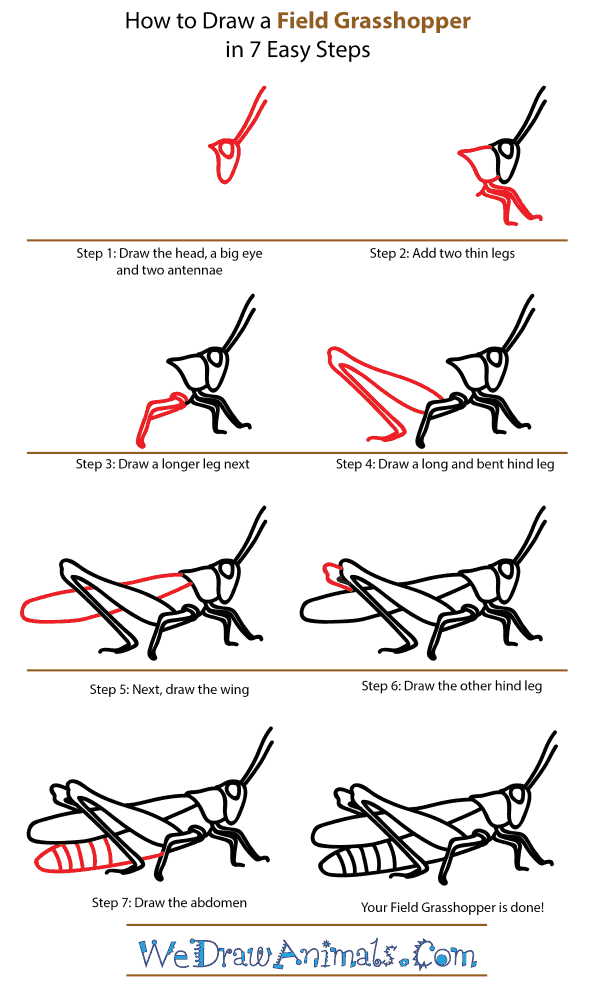In this quick tutorial you'll learn how to draw a Field Grasshopper in 7 easy steps - great for kids and novice artists.
The images above represent how your finished drawing is going to look and the steps involved.
Below are the individual steps - you can click on each one for a High Resolution printable PDF version.
At the bottom you can read some interesting facts about the Field Grasshopper.
Make sure you also check out any of the hundreds of drawing tutorials grouped by category.
How to Draw a Field Grasshopper - Step-by-Step Tutorial
Step 1: Draw the head, with a large eye and two large curved antennae
Step 2: Add the next section of the body and two thin legs
Step 3: Draw the next set legs, longer than the first
Step 4: Draw a long leg bent behind it (like its leg is bent behind it at the knee)
Step 5: Draw the wing down the middle behind the bent back leg
Step 6: Draw the other hind leg
Step 7: Underneath the wing, draw the abdomen (oblong shape) and add lines on it.
Interesting Facts about the Field Grasshopper
This small insect shows a great variety in its appearance, its colors ranging from brown to black, green, white and purple. Most of these creatures are brown in color, but the other colorings are not rare to see among their numbers. In addition to the coloring of their bodies, the field grasshopper’s wings can also be quite varied. The wings of this grasshopper can be mottled in pattern, striped, stripe-mottled or entirely plain. This is associated with their body color, as green and purple grasshoppers tend to have plain wings, black ones have mottled wings, and the brown variant of this species has a varying wing pattern that differs from insect to insect. This animal is found in the dry shrub lands of Europe, North Africa and Asia. They prefer to live in heathlands, areas with acidic soil and low-growing woody vegetation, because there is less human intervention in these habitats than one would find in more commonly-used agricultural areas. They are very common in these areas additionally because there is no livestock grazing that can interrupt their food supply. The field grasshopper is an herbivore that eats mostly grasses.
Did you know?
- The field grasshopper is a “univoltine” species, meaning that they reproduce once per year.
- The longer the female grasshopper’s hind femur is, the more eggs she will produce after mating.
- Males will gain the attention of females by singing. If a female is interested, she will produce a song of her own in return. This back-and-forth will often continue until either mating occurs, or the female loses interest.
- Smaller field grasshoppers will produce fewer eggs than the larger members of their species, but will often produce them at a faster rate.
- Because female field grasshoppers tend to have shorter life spans than males, there is a disparity between the sexes of this species, with males dominating in numbers.
- The larger the egg produced is, the larger the hatchling grasshopper will be.
- Egg size is influenced by two factors. The first is the age of the mother grasshopper. The older they are, the more eggs they will produce. The second is the time in the breeding season in which the eggs are laid. If the eggs are laid later in the breeding season, they will be smaller than eggs laid in the earlier months.
This species is very adaptive, able to engage in a process called “diapause,” which is a delay in development caused by environmental conditions that will make it hard for eggs and hatchlings to thrive. While the offspring are still in their eggs, there is not much water needed to sustain them. However, they cannot become completely dehydrated. It matters far less how much water they take in, than it does that they take in any water at all. Grasshopper eggs will undergo diapause during the winter, but will usually hatch ten weeks after being laid. The development of the hatchlings is not affected by humidity, but rather by the source of heat that they receive their warmth from. Radiant heat helps them to reach adulthood on average six weeks sooner than other grasshoppers who do not have access to radiant heat. Pollution caused by humans has negatively impacted the growth of this species, because grasshoppers will use their body’s own resources to fight against harm caused by heavy metals and garbage in their habitat, instead of focusing these internal resources on their own growth.








